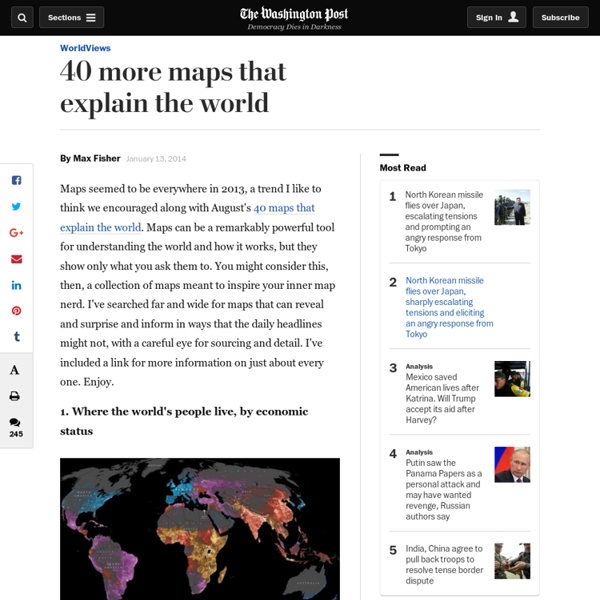40 maps that explain the world
By Max Fisher By Max Fisher August 12, 2013 Maps can be a remarkably powerful tool for understanding the world and how it works, but they show only what you ask them to. So when we saw a post sweeping the Web titled "40 maps they didn't teach you in school," one of which happens to be a WorldViews original, I thought we might be able to contribute our own collection. Some of these are pretty nerdy, but I think they're no less fascinating and easily understandable. A majority are original to this blog, with others from a variety of sources. I've included a link for further reading on close to every one.
EarthPulse, Maps, Global Trends, Human Impact
Globalization, the international exchange of goods, services, cultures, ideas, has brought increased wealth for many and transformed forever the way humans interact. But while its roots may be in commerce, globalization's effects can be very personal. Advances in communication and transportation have created a rich, unprecedented mixing of cultures throughout the world. But there is a drawback.
The Ocean Cleanup
Plastics in the marine environment have become a major concern because of their persistence at sea, and adverse consequences to marine life and potentially human health. Implementing mitigation strategies requires an understanding and quantification of marine plastic sources, taking spatial and temporal variability into account. Here we present a global model of plastic inputs from rivers into oceans based on waste management, population density and hydrological information. Our model is calibrated against measurements available in the literature. We estimate that between 1.15 and 2.41 million tonnes of plastic waste currently enters the ocean every year from rivers, with over 74% of emissions occurring between May and October.
The World Factbook
People from nearly every country share information with CIA, and new individuals contact us daily. If you have information you think might interest CIA due to our foreign intelligence collection mission, there are many ways to reach us. If you know of an imminent threat to a location inside the U.S., immediately contact your local law enforcement or FBI Field Office. For threats outside the U.S., contact CIA or go to a U.S. Embassy or Consulate and ask for the information to be passed to a U.S. official. Please know, CIA does not engage in law enforcement.
How to Make a Map in Illustrator
Every time I start thinking of a tutorial to write, I try to show techniques that I use in my job as a designer. For example, today I will be showing you how to make a nice little map. I was called to make a map for the university which was tedious but still fun. This can also be a neat little add-on to a party invitation or the like.First and most importantly turn on some music! Some Armin van Buuren thumping in the background helps the creative process.
Geo-Educator of the Week Series
Xpeditions is now archived in National Geographic Education's new website—natgeoed.org If you liked Xpeditions, you'll love the new media-rich natgeoed.org. Explore the new site now for activities, maps, interactives, videos, homework help, and more! www.natgeoed.org Please note: to search for Xpeditions content, check the “include archive” filter. Geo-education is not something that is new.
Global SO2 pollution map – Google My Maps
Bayswater power station Callide power station Eraring power station
Department of History - Our Atlases
About Our Atlases In 1938 the predecessors of today's Department of History at the United States Military Academy began developing a series of campaign atlases to aid in teaching cadets a course entitled, "History of the Military Art." Since then, the Department has produced over six atlases and more than one thousand maps, encompassing not only America’s wars but global conflicts as well. In keeping abreast with today's technology, the Department of History is providing these maps on the internet as part of the department's outreach program. The maps were created by the United States Military Academy’s Department of History and are the digital versions from the atlases printed by the United States Defense Printing Agency.
Activities Index
This website would like to remind you: Your browser (Firefox 17) is out of date. Update your browser for more security, comfort and the best experience on this site. Xpeditions is now archived in National Geographic Education's new website—natgeoed.org If you liked Xpeditions, you'll love the new media-rich natgeoed.org. Explore the new site now for activities, maps, interactives, videos, homework help, and more!
Coronavirus 2020-nCoV
Lancet Inf Dis Article: Here. Mobile Version: Here. Data sources: Full list. Downloadable database: GitHub, Feature Layer. Lead by JHU CSSE.
indoeuropean.html
The Indo-European Family of Languages Map of European Languages Indo-European Chart Map of Indo-Iranian Languages
Native American Languages and Groups
Media Credits The audio, illustrations, photos, and videos are credited beneath the media asset, except for promotional images, which generally link to another page that contains the media credit. The Rights Holder for media is the person or group credited. Rights Holder
A Collection Of “Best” Lists Related To International Terrorism
In light of the terrorist attacks in Paris last night, I thought that teachers would find it useful for me to bring links to all my international terrorist-related “Best” lists together in one post: The Best Resources For Teaching & Learning About The Paris Attacks The Best Ways To Teach About The Paris Massacre (about the Charlie Hebdo massacre earlier this year) The Best Resources For Learning About The Islamic State & The Campaign Against It. The Best Resources For Learning About What’s Happening In SyriaThe Best Sites To Help Teach About 9/11



